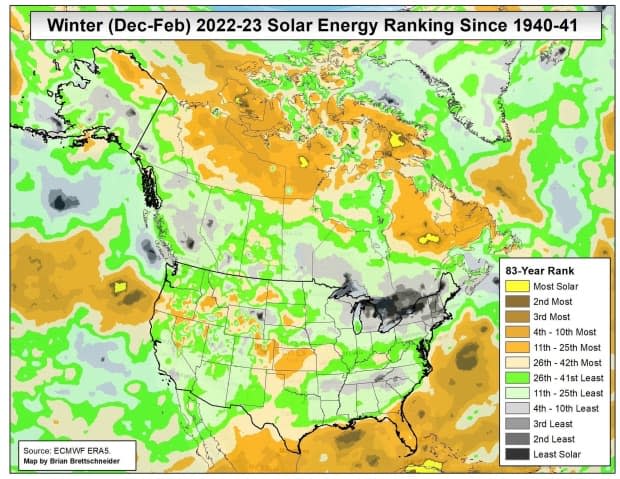Ontario emerges from the darkest winter in over 80 years, new data suggests

The arrival of spring may be a bit more of a relief in Ontario than usual this year, as new data suggests this winter was the darkest in the province in more than 80 years.
While southern Ontario as a whole saw the least sunlight, the Thunder Bay area wasn't far behind, according to data compiled by Brian Brettschneider, climate scientist with the United States National Weather Service in Alaska.
"Here in Alaska, the month of February was really remarkably cloudy," Brettschneider said. "There just never seemed to be any sunlight."
He said he decided to take a look at whether there was any data to support that, by analysing information from European Centre for Medium-Range Weather Forecasts, which has the "gold standard of archived climate data."
Brettschneider used that data to create maps showing the amount of solar energy that reached North America from December to February.

"What really stood out was kind of a blob of low solar energy really right around the Great Lakes, kind of centred over southern Ontario," he said. "That's really what stands out more than anything else on the map."
A 'remarkable' dark January
Brettschneider said that while December doesn't generally see much in the way of solar energy, January was "remarkable" for how much darkness and cloud cover it saw.
"There was a very persistent area of high pressure over and south of Hudson Bay, extending all the way over to the Maritime provinces," he said. "That sent, really, an east flow the entire month, and that's a very moist flow.
"If you get winds that flow out of the north or the west, it's a much drier flow and much less cloud coverage," Brettschneider said. "Then the month of February wasn't quite as extreme as January, but it wasn't far behind. There was a very persistent area of high pressure over the U.S. East Coast, and that sent the flow from the south for most of the month, and then that flow is a moist flow coming from the Gulf of Mexico."
Brettschneider said the Great Lakes themselves were largely open and unfrozen over the winter, providing a source of moisture to help cloud development in the area.
WATCH | The calendar says it's spring, but Thunder Bay, Ont., gets dump of snow:
If you were feeling a bit down more than usual this winter, the new data may provide light on why.
The frozen gloom of the winter months can have an effect on mental health, said Nicole Stewart, manager of mental health promotion and education at the Canadian Mental Health Association's (CMHA) Thunder Bay branch.
Winter darkness can lead to a type of depression called seasonal affective disorder (SAD), which Stewart said seems to be related to the the amount of sunlight exposure people get.
"It varies from person to person, but typically we feel like we're sleeping all the time or having trouble getting a good night's sleep," Stewart said. "We might have difficulty carrying out tasks because we're tired. Maybe our appetite has changed.
"Typically when we're feeling a little bit more low-affect or depression-type symptoms, we have more cravings for sugary or starchy foods, and a result of that is often weight gain," she said. "We often feel sad, or guilty or down on ourselves, like we're not doing enough, or we wish we were a little bit more productive. And when we're not, we get upset about that.
"We can feel hopeless. We feel irritable. We sometimes avoid people when we're feeling upset or like we're not ourselves. We might start withdrawing from the activities that we used to enjoy."
According to statistics provided by the CMHA, about three per cent of the northern Ontario population shows symptoms of SAD.
With regards to this past winter, Stewart said there seemed to be more interest in light therapy lamps, which are designed to mimic natural sunlight and can help alleviate SAD symptoms, than in previous years.
"We did have much more people interested in picking one up this year than last year, when we were giving them away for prizes when we were doing training and things like that," she said. "In my personal opinion, we went through them much faster this year than we did last year."

Of course, spring officially began on Monday, promising sunnier skies and warmer weather. But there will be more winters, and Stewart said there are some things people can do to help during the darker months.
"Your first step would be getting that medical opinion, making sure that you're ruling out any other type of medical diagnosis. But there's a lot of things that you can do at home that help — exercising regularly, eating a healthy diet, having good sleep hygiene is really important. And having that sleep routine, so that your body gets used to when you're supposed to be sleeping and when you're supposed to be waking up."
Stewart also suggests staying connected to others, spending time outdoors during the day, and arranging things so people have exposure to sunlight indoors — like moving work stations closer to windows or trimming trees or hedges that block sunlight.


